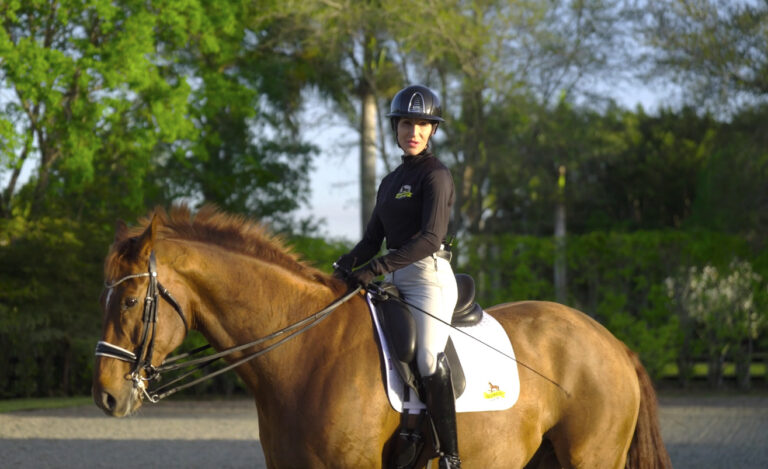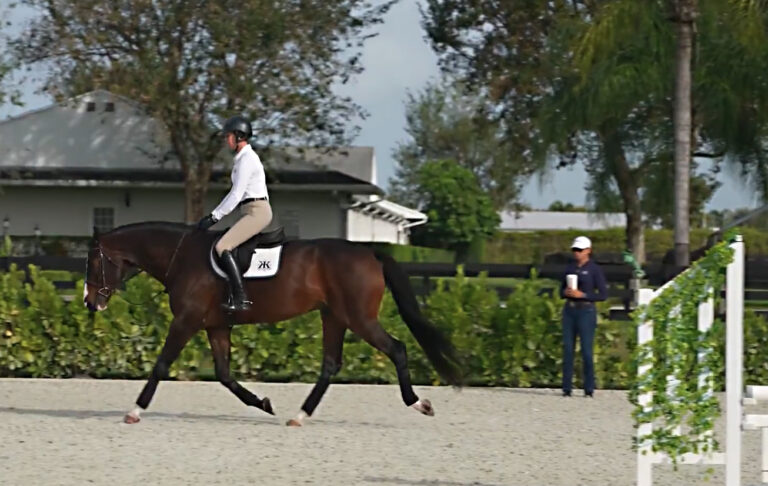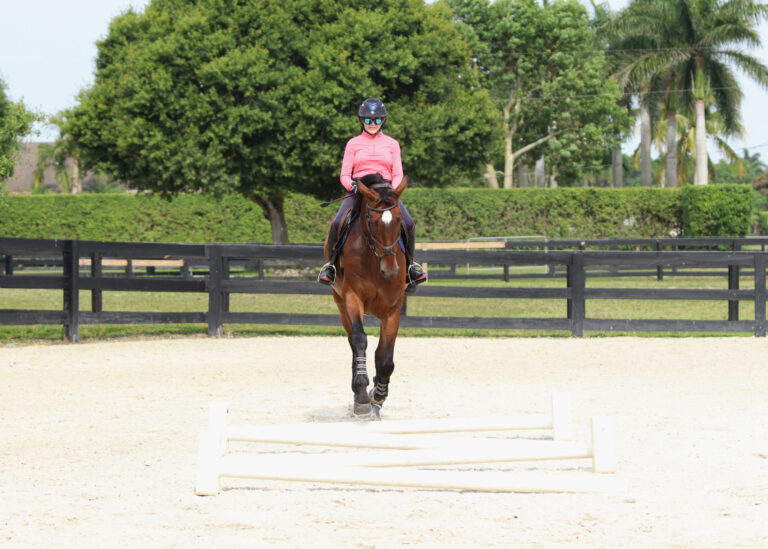When training a horse, you are dealing with an emotional animal that is so aware of body language it is as if he can read your mind. Music connects with humans on an emotional level and can affect us strongly. If we are affected in a positive way—our mood brightens or our energy is balanced—then the horse will feel the benefits of that as well.
This article was adapted from “Freestyle” by Sandra Beaulieu and is available at HorseandRiderBooks.com
Music can also improve the way we progress through the Training Scale—the six classical building blocks of horse training: rhythm, suppleness, contact, impulsion, straightness, and collection. Rhythm and tempo are at the “base” of the Training Scale, with the other building blocks progressively “stacked” upon it. Perhaps you have a young horse that is learning how to maintain a steady trot, or you are a beginner rider that is learning how to post. In these cases, music can regulate your body, helping you focus on a metronome-like beat in a fun way.
With modern technology, there are many ways to find and save music you like. First, you need to learn how to determine what music works with your horse’s stride. This will give you a starting point, and from there, you can find music with the same rhythm as your horse. When you ride to a song with the same walk, trot, and canter beat as your horse, wonderful things will happen. The music will help you and your horse become “in sync,” and it will help develop a steadier connection, as well as better engagement of the horse’s hind end and lift of the horse’s back. The reason for the latter is that your seat is the most important tool you have to balance your horse. If your seat is moving in a steady beat, it will encourage the horse to lift up underneath you.
There are many benefits of riding to music, but first, let’s take a look at the necessary staring point: the beat.
Begin with the Beat
In order to understand the benefits of riding to music, you need to know how to choose music that matches your horse’s stride. If you are like most riders, you have heard people mention “BPM” before, and you may be a little confused about what that means. I know I was in the beginning!
BPM stands for beats per minute. This is the number of footfalls your horse takes in the span of one minute. The reason this is important is that it helps you narrow your music choices—whether for training purposes or competition—to songs that have the greatest potential to match your horse’s stride. This is most important for competition Freestyles to help accent a steady tempo and to highlight cadence, impulsion, and overall quality of the gaits.
Have you ever watched a Freestyle and felt like the horse was rushing to catch up with the music? Or perhaps the music was nice but did not connect to the horse’s stride and sounded more like background music? Usually this is due to a mismatch when it comes to a song’s beats and your horse’s hoofbeats. When you’re training, matching the footfalls to the music can help you with your own rhythm and timing; in competition, working with the BPM grabs the attention of your judge and your audiencemaking the horse look like he is really “dancing” to the music. (Note that just because the beats of your horse’s stride and the beats of the song match perfectly doesn’t always mean that music is a good fit. You also need to take into account the way a song flows with your horse and whether its “feel” matches your horse’s personality—more on this later.)
There are two popular methods to determine your horse’s BPMs: traditional and modern. For both you will need the following items to make the process easier:
- A stopwatch, timer, or cell phone.
- Leg wraps in one or two colors.
- Video camera or cell phone with video capability (optional).
- Barn friend (assistant).
Finding Your Horse’s BPMs
1. Start by wrapping one of your horse’s front legs with a wrap in a color that is easy to see. You only need to wrap one leg for this purpose, but you might find it easier to see your horse’s movement on a video if you wrap all four, using two different color wraps. For example, if you have a dark horse, wrap three legs in a medium hue such as blue and use a white wrap on the “leading leg.” The leading leg is the inside front leg in whichever direction the horse is traveling. If he is trotting on a circle to the left, his front left leg would be considered the leading leg. This applies to all gaits. (Note: In the walk and trot you can also count both front legs for their beats, but it is easier to use the method I describe below for the leading leg, and then multiply by two.) In a competition the judge will typically watch this leading leg to determine how well you are matching the beat of the music.
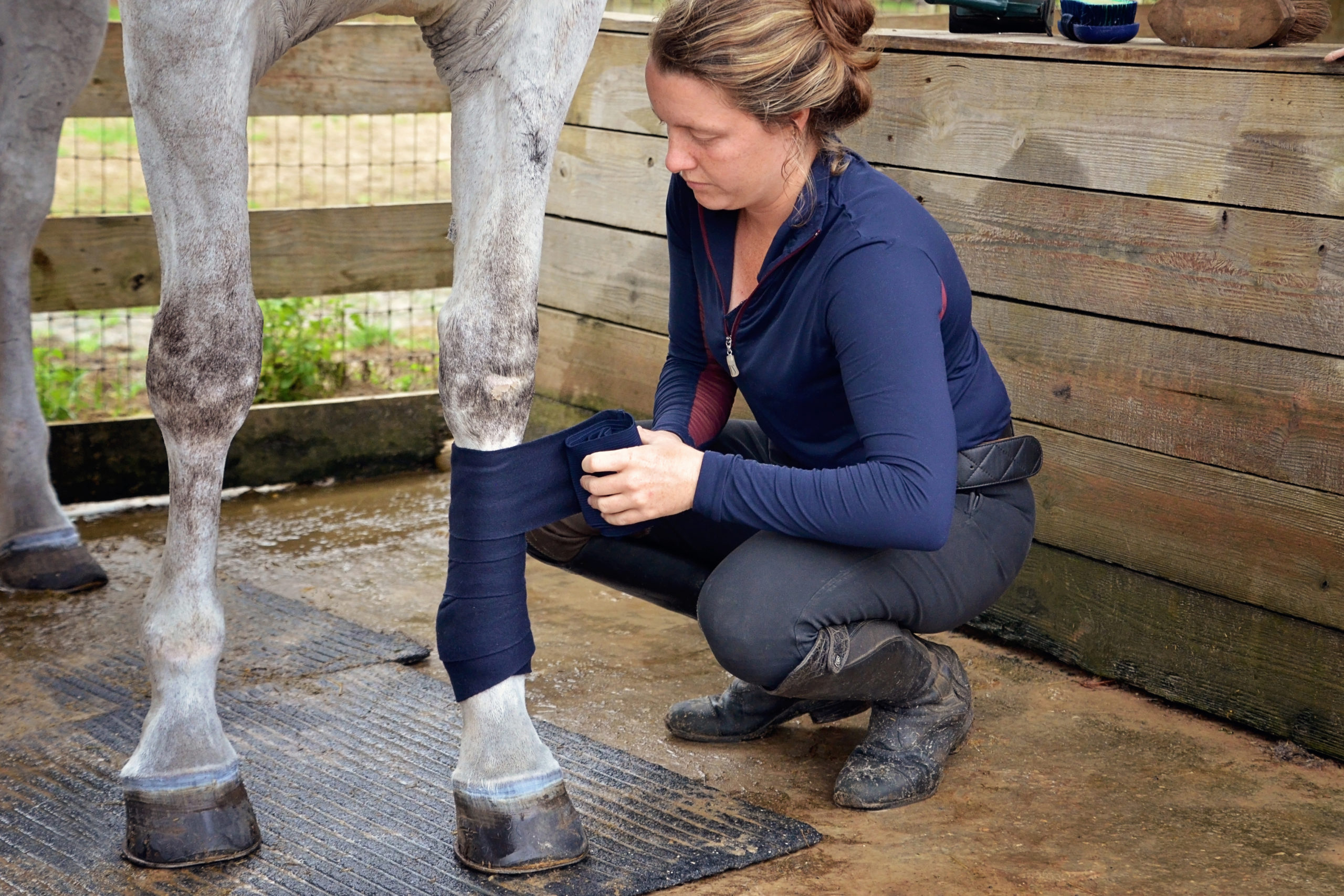
2. Take the time to warm up first so that you can be sure to have the best representation of each of your horse’s working gaits.
3. When you are ready, have your assistant watch (or video) your horse at all three gaits. She should watch the horse’s leading leg. Every time that hoof touches the ground it should count as one “beat.”
- When using the traditional method: Using a stopwatch or the timer on your cell phone, have your assistant set the timer for one minute. Ride in a consistent working or collected gait, staying on the rail in a straight line for as long as possible. Your assistant should count the number of footfalls from the leading foreleg for one minute (or count both front legs in the walk and trot). This will give you the beats per minute (BPM) of your horse’s gait. Repeat once or twice more and then find the average.
- When using the modern method: If you prefer to use this method to find your horse’s BPMs, you will need to download a metronome/BPM app on your phone to use instead of a stopwatch. Search for “BPM” or “metronome” in your app store to find a variety of free apps you can try. Using an app is handy when you are short on time and need to quickly determine a BPM.
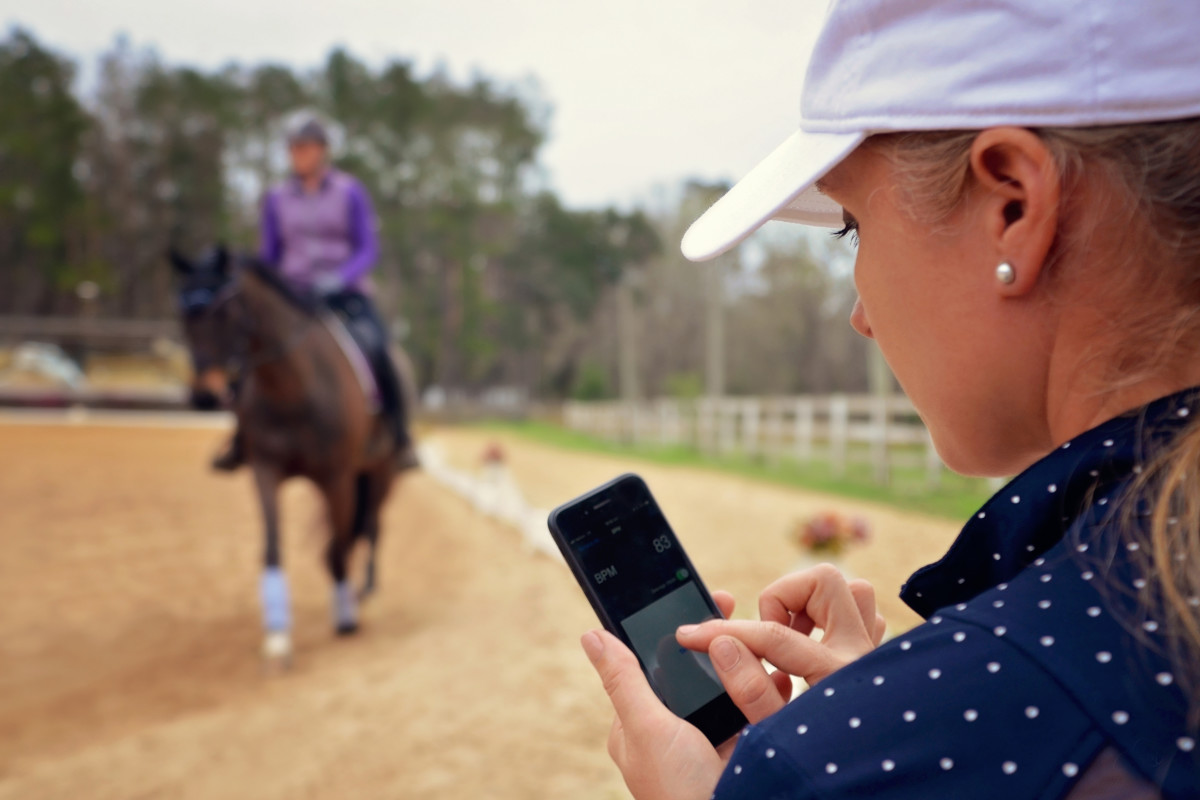
A metronome app will ask you to adjust the beat up or down until a “beep” sound matches the footfall of the horse’s leading foreleg.
A BPM app will need your assistant to “tap” the screen every time your horse’s front hoof touches the ground. The app will calculate the BPM average and display it on the screen immediately.
I like to use a BPM app when I am listening to music. When I play a song, I try to tap my foot to the beat of the music. Once I feel the beat, I start to tap the screen, and you can then see how closely the music’s BPM matches your horse.
Walk
At the walk, every time the leading front hoof touches the ground, you (or your assistant) will count it as one beat for the walk. Most horses fall between a 45 and a 60. For the walk you can also count both front feet as they land on the ground and find music that would be within a 90 to 120 range. Horses that have a steady, marching rhythm go really well to music that accentuates both front legs. For example, your horse’s BPM for the walk might be 50, but music that has an obvious BPM of 100 will work as well, as long as the music is not too overpowering.
Trot
The trot has a fairly wide range of beats, tending to run from 72 to 85 BPM, depending on how much suspension and ground cover your horse has. Typically, a Warmblood, for example, will have lower numbers and smaller, quicker horses will have a higher number. You can also count both front legs and your range will be somewhere between a 144 and 170. I find it easier to count the beats for the leading leg with my smartphone app and then multiply by two.
Canter
The canter range for most horses is between 90 to 110. It is typically twice the number of the walk. If your horse is a 48 at the walk he will most likely be around a 96 for the canter. When this is the case, note that it is easier to find songs that will transition nicely from the walk to the canter. A larger horse usually has a canter BPM in the mid to upper 90s, while a smaller horse or pony may have a canter beat over 100.
Take a Video
Take the opportunity to have your assistant video your horse at a consistent walk, trot, and canter in both your working/collected gaits and your lengthened/extended gaits. Stay in each working gait for at least one full minute. You can then count the footfalls from the comfort of your own home. The video will also be helpful when it comes time to test out different pieces of music for your Freestyle.
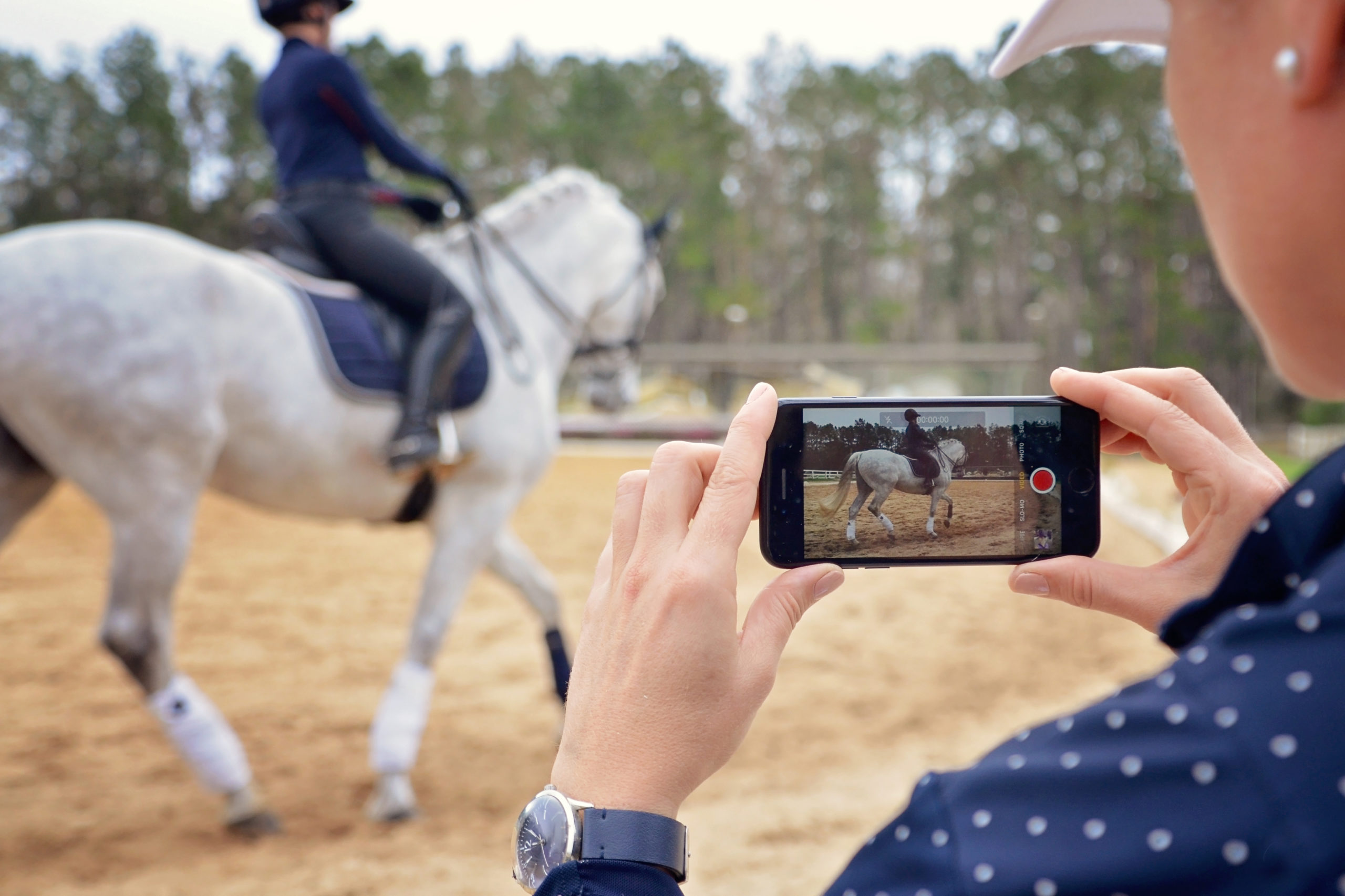
Tempo vs. Rhythm
In dressage, you will commonly hear these two terms getting confused with one another. Let’s review their meanings as related to general riding and training, and also to musical Freestyles.
General Training
In relation to riding and training, the tempo refers to the rate of repetition of the stride, and the rhythm refers to the footfall sequence of the stride.
Tempo is really your horse’s beats per minute (BPM). A horse with good tempo stays steady and even; a horse that rushes or changes speed demonstrates a lack of tempo.
As mentioned, the rhythm in riding refers to the sequence of the footfalls. It has to do with the quality of the horse’s gait, which is why it is at the bottom of the Training Scale. Rhythm is reliant on tempo and energy. As an example, at the canter there should be a clear three-beat rhythm, with the correct sequence of outside hind, diagonal pair, and inside front. If the horse loses his balance and starts to cross-canter, he has lost the rhythm because the footfalls are no longer correct.
When defining tempo and rhythm musically, we must also define “beat.” A musical beat is the foundation of rhythm. It is the steady, repeating pulse that you want to tap your foot to. You tap the beat to determine the BPM of your horse’s stride (as we just discussed) and of your music.
In a Freestyle
In relation to a musical freestyle, the tempo refers to your horse’s BPM and the music’s BPM. The goal is to have both sync together. Rhythm refers to the flow of music or lyrics. In a song, the rhythm may change throughout, but the underlying tempo stays the same. It is the same as your horse changing from a collected canter to an extended canter: you want the tempo to remain the same while the stride changes length and scope.
This article was adapted from “Freestyle” by Sandra Beaulieu and is available at HorseandRiderBooks.com





